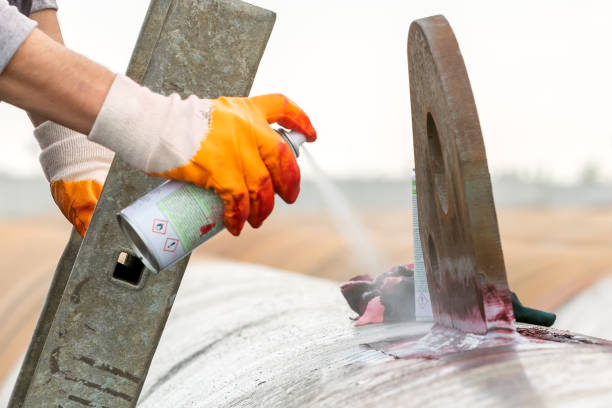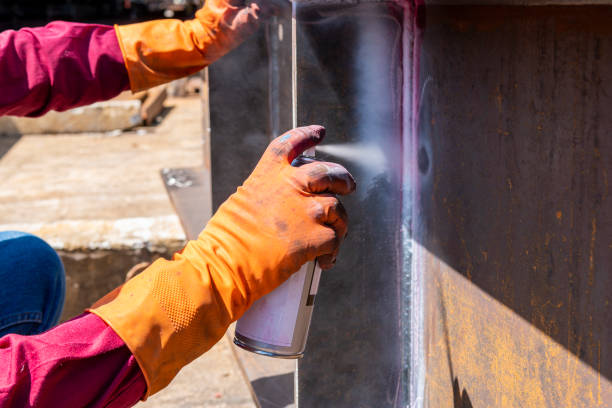Significance of Liquid Penetrant Testing (LPT)
- February 24, 2024
- Posted by: Velosi Author
- Categories: Civil, Insights, NDT

Liquid Penetrant Testing (LPT) is an innovative non-destructive testing (NDT) technique which assists experts to easily detect the small cracks and faults within an asset. It is well known testing methodology that can ease your testing projects without creating a hassle.
Have you ever thought about how experts find small cracks or problems in metal parts, welds, or ceramics?
Learning The Art and Science of Liquid Penetrant Testing (LPT)
Imagine a situation where a part of a power plant or machine/engine is tested very thoroughly for surface-breaking defects such as cracks, pores etc without causing any damage and ensuring the element does not get any scratches. It may sound impossible, but it’s the real-life advantage of non-destructive testing (NDT) using liquid penetrants. Let us understand this in more detail!
Liquid Penetration or we also call it the Dye Testing technique helps in detecting all sorts of cracks or flaws on the surface of all metal & plastic materials. Considering its versatility, it can even be used on glass surfaces as well. Moreover, it’s an important method used in many different major industries including oil and gas.
Let us dive into the process. Imagine a metal part gets cleaned to remove any dirt or particles on its surface. Next, a brightly coloured liquid is applied, it can be fluorescent or a visible dye. This liquid enters any small cracks in a surface and fills them up.
After waiting for a certain time, the extra dye is taken off, and a special powder is put on. The removal process of the trapped liquid from the cracks takes place, making them easier to see in the right light. Here the cracks the easily visible.

Applications and Impact: From Bridges to Machinery
Liquid penetrant testing can be used in many ways, which makes it very interesting. It can be used for many things, like finding small cracks in welds and checking if important parts are strong. The critical factor is not only about finding mistakes; it’s about safeguarding asset integrity and creating safer spaces within the environment. Furthermore, liquid penetrant testing requires more than just a method; it requires expertise. This technique requires a proper balance of skills, hard work, dedication, and focus.
Liquid Penetrant Testing (LPT) holds immense importance in both the construction and oil and gas industries due to its versatile applications in ensuring the integrity and reliability of critical components.
In the construction industry, LPT plays a crucial role in quality control and inspection of welds, joints, and other structural elements. Detecting surface defects such as cracks or discontinuities helps ensure the durability of buildings, bridges, and other infrastructure projects. This proactive approach to identifying flaws contributes to the longevity and safety of structures, minimizing the risk of catastrophic failures.
In the oil and gas industry, the detection of surface flaws in welds or materials helps prevent potential leaks, ruptures, or structural failures that could lead to environmental hazards, production disruptions, or safety incidents. Liquid Penetrant Testing is an essential tool for ensuring the structural integrity of critical equipment, contributing to the overall safety and efficiency of oil and gas operations.
Furthermore, liquid penetrant testing is useful in both industries because it doesn’t damage the parts being checked. It’s a cost-effective way to thoroughly inspect components without harming them. This sensitive testing method is a key part of ensuring quality. It helps find and fix problems prior to any hazardous incident, which helps keep infrastructure and industrial facilities safe, reliable, productive, and long-lasting.
Conclusion: Craftsmanship and Innovation
To conclude, professional experts make sure that a safe environment is created and are responsible for finding mistakes. An inspector finding a hidden problem could save lives. This job needs both technical skills and a strong sense of responsibility. One must be committed to complete the job accurately and efficiently at all costs.
Following innovative solutions? NDT is always evolving, with new ways of doing things and new tools emerging to keep up with the needs of the industry. Liquid testing is getting better and can-do wonders in the future.
Please contact us for more information and assistance.



